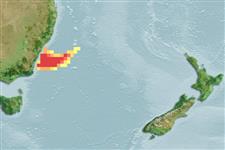分类 / Names
俗名 | 同种异名 | Catalog of Fishes(属, 种) | ITIS | CoL | WoRMS | Cloffa
Teleostei >
Stomiiformes (Lightfishes and dragonfishes) >
Stomiidae (Barbeled dragonfishes) > Melanostomiinae
Etymology: Eustomias: Greek, eu = good + Greek, stoma = mouth (Ref. 45335); australensis: Named for its place of capture, Australia.
Environment: milieu / climate zone / depth range / distribution range
生态学
海洋 深海区的; 深度上下限 0 - 500 m (Ref. 11333). 深水域
Southwest Pacific: Endemic to New South Wales, Australia.
西南太平洋: 澳洲新南威爾斯的特有種。
大小 / 重量 / 年龄
Maturity: Lm ? range ? - ? cm
Max length : 8.7 cm SL 雄鱼/尚未辨别雌雄; (Ref. 11333)
简单描述
检索表 | 型态特徵 | 形态测量图
背的软条 (总数) : 23; 臀鳍软条: 36; 脊椎骨: 67. Two terminal bulbs separated by a distance equal to the distal bulb length. Barbel 55% SL. Terminal filament longer than 9.4% SL with the tip broken. Distal bulb large, 1.6 times length of proximal bulb. Axis of stem pigmented, dark proximally, light distally. External chevron-shaped or roundish striated area on stem well pigmented. Middorsal paired spots between occiput and dorsal-fin origin 8 (Ref. 11333).
被距离分开的二个末端的球茎等于末稍球茎长度。 触须 55% SL。 具有被打破的顶端的末端丝状突起长度超过 9.4% SL。 末稍球茎大的,1.6 倍近端的球茎的长度。 茎的轴有颜色, 深色的近端地, 末梢部地的光。 在茎上的外部的锯齿形或圆的有条纹的区域很好地有颜色。 在后脑部与背鳍起点 8 之间的背面中央的成对斑点.(参考文献 11333)
Mesopelagic species (Ref. 7300, 75154).
海洋中层鱼种.(参考文献 7300)
Life cycle and mating behavior
成熟度 | 繁殖 | 产卵场 | 卵 | 孕卵数 | 仔鱼
西南太平洋: 澳洲新南威爾斯的特有種。
Paxton, J.R., D.F. Hoese, G.R. Allen and J.E. Hanley, 1989. Pisces. Petromyzontidae to Carangidae. Zoological Catalogue of Australia, Vol. 7. Australian Government Publishing Service, Canberra, 665 p. (Ref. 7300)
世界自然保护联盟红皮书 (Ref. 130435: Version 2024-2)
人类利用
渔业: 没有兴趣
工具
特别资料
下载 XML
网络资源
Estimates based on models
Preferred temperature (Ref.
123201): 13.7 - 21.3, mean 18.5 °C (based on 6 cells).
Phylogenetic diversity index (Ref.
82804): PD
50 = 0.5000 [Uniqueness, from 0.5 = low to 2.0 = high].
Bayesian length-weight: a=0.00302 (0.00116 - 0.00786), b=3.12 (2.89 - 3.35), in cm total length, based on LWR estimates for this (Sub)family-body shape (Ref.
93245).
营养阶层 (Ref.
69278): 3.9 ±0.7 se; based on size and trophs of closest relatives
回复力 (Ref.
120179): 高度, 族群倍增时间少于 15个月 (Preliminary K or Fecundity.).
Fishing Vulnerability (Ref.
59153): Low vulnerability (10 of 100).
